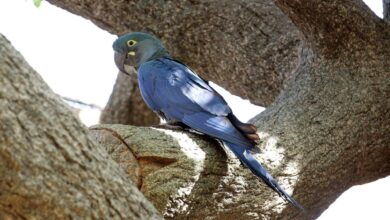Rare New Discoveries of Albinism in Ecuador’s Wildlife and Beyond

Ecuador’s National Institute of Biodiversity (Inabio) recently documented the first case of albinism in an Andean porcupine, opening the door to further discoveries in Latin America’s rich biodiversity. Similar rare occurrences are shaping our understanding of wildlife across the continent.
In an extraordinary discovery, the Instituto Nacional de Biodiversidad (Inabio) of Ecuador announced the first documented case of albinism in an Andean porcupine (Coendou Quichua), a species endemic to the neotropical regions of South and Central America. This remarkable find occurred in the tropical province of Santo Domingo de los Tsáchilas, a biodiverse area stretching from the Andean foothills to Ecuador’s coastal plains.
The female porcupine was rescued after being found injured on a highway near the Bosque Protector La Perla, a reserve known for its efforts to conserve Ecuador’s wildlife. Despite efforts to save the animal, it succumbed to its injuries while receiving veterinary care. However, the porcupine’s significance as the first known albino of its species has led scientists to preserve her skin, skull, and skeleton for future research.
Inabio researchers described the porcupine as having yellowish quills on its back and white quills on its underside. It also had characteristic albino traits such as red eyes and pink skin around the muzzle, ears, and feet. DNA samples were extracted to confirm its identification as Coendou Quichua, adding an invaluable specimen to Ecuador’s rich mammalian biodiversity collection.
The research team, led by Jorge Brito, Pamela Logan, Jason Crespo, and Jaime Culebras, documented the case with the Bosque Protector La Perla, Photo Wildlife Tours, and Fundación Cóndor Andino. This rare occurrence is a significant discovery for Ecuador’s biodiversity and highlights the potential for new findings in wildlife research across Latin America.
Albinism: A Rare Condition in Nature
Albinism, a genetic condition resulting from a lack of pigmentation, affects animals across various vertebrate groups, including fish, reptiles, amphibians, birds, and mammals. Though rare, albinism has been documented in several species in Latin America, but this is the first known case involving the Andean porcupine.
The occurrence of albinism in the animal world is significant because it offers a glimpse into the genetic diversity and mutations within populations. Albinism can impact an animal’s survival, as the absence of natural camouflage makes them more visible to predators. In contrast, sensitive skin and eyes may make it harder for animals to thrive in the wild. Yet, documenting these conditions contributes to our broader understanding of genetic variations and the evolutionary processes in species across different environments.
The albino Andean porcupine is just one of 16 species within the Coendou genus. It is distinguished by its spiny coat and bicolored or tricolored defensive quills. While color abnormalities are rare in this species, this discovery has prompted renewed interest in the genetic makeup of porcupines and other rodents across the region.
Latin America’s Other Notable Wildlife Discoveries
The discovery of the albino porcupine in Ecuador is part of a broader trend in Latin America, where unique scientific discoveries have made headlines in recent years. Latin America is home to some of the world’s most diverse ecosystems, and its wildlife continues to surprise researchers with unique traits and genetic mutations.
Albinism: A Rare Condition in Nature
Albinism, a genetic condition resulting from a lack of pigmentation, affects animals across various vertebrate groups, including fish, reptiles, amphibians, birds, and mammals. Though rare, albinism has been documented in several species in Latin America, but this is the first known case involving the Andean porcupine.
The occurrence of albinism in the animal world is significant because it offers a glimpse into the genetic diversity and mutations within populations. Albinism can impact an animal’s survival, as the absence of natural camouflage makes them more visible to predators. In contrast, sensitive skin and eyes may make it harder for animals to thrive in the wild. Yet, documenting these conditions contributes to our broader understanding of genetic variations and the evolutionary processes in species across different environments.
The albino Andean porcupine is just one of 16 species within the Coendou genus. It is distinguished by its spiny coat and bicolored or tricolored defensive quills. While color abnormalities are rare in this species, this discovery has prompted renewed interest in the genetic makeup of porcupines and other rodents across the region.
In Colombia, researchers recently uncovered a rare species of pink river dolphin, notable for its distinct pigmentation. These dolphins inhabit the Amazon and Orinoco river basins, and their unusual coloring has intrigued scientists for decades. The pink hue is believed to result from capillary placement under the skin, though in some cases, albinism could play a role in creating lighter-colored individuals. Like the albino porcupine, the pink river dolphins face conservation challenges, as they are vulnerable to habitat degradation and human activities.
Further south in Argentina, another remarkable discovery came in the form of a rare melanistic jaguar. Melanism, the opposite of albinism, is characterized by excess dark pigmentation. While melanistic jaguars have been documented in other parts of the world, they are scarce in Argentina. Found in the country’s remote jungles, the melanistic jaguar has been a symbol of the region’s conservation efforts, as the species is considered critically endangered due to habitat loss and poaching.
Similar cases of albinism have also been recorded in amphibians, such as albino tree frogs discovered in Brazil’s Pantanal wetlands. The region is renowned for its rich biodiversity, and discoveries like these provide insight into the genetic diversity of amphibians, many of which are threatened by climate change and environmental degradation. Albinism in these frogs makes them more vulnerable to predators, offering further evidence of the challenges mutations can pose in the wild.
These extraordinary findings from across Latin America provide insight into the region’s genetic diversity and highlight the need for continued conservation efforts to protect the habitats of these rare creatures.
Conservation and the Challenges of Protecting Endangered Species
While these rare discoveries showcase Latin America’s incredible biodiversity, they also underscore the importance of protecting fragile ecosystems from human activity. In the case of the albino porcupine, the animal was found injured on a highway—a poignant reminder of the dangers that human encroachment poses to wildlife.
Conservationists have long been challenged by expanding infrastructure, such as roads and highways, through critical habitats. In Ecuador and other countries, highways cutting through forests and wetlands create deadly obstacles for animals and fragment ecosystems. To address these issues, governments and conservation organizations have begun implementing wildlife corridors, which allow animals to move safely between habitats.
However, infrastructure is not the only threat. The rise of illegal logging, mining, and agriculture has led to widespread deforestation across Latin America, threatening countless species. In the Amazon rainforest, home to the world’s most diverse wildlife, habitat loss has increased alarmingly. Protecting biodiversity hotspots like Caral in Peru and Carajás in Brazil has become more urgent than ever, as these areas’ destruction impacts local wildlife and contributes to global climate change.
Ecuador’s commitment to biodiversity conservation is evident in the work being done by institutions like Inabio, but the challenges of preserving the country’s natural heritage remain immense. The discovery of the albino porcupine serves as a reminder of the importance of scientific research and documentation in conservation efforts. By studying these rare occurrences, researchers can better understand the genetic health of populations and develop strategies to protect vulnerable species.
The Role of Science and Innovation in Conservation
Technology and scientific research advances have opened new doors for conservationists working to protect Latin America’s biodiversity. DNA analysis, such as the one conducted on the albino porcupine, allows scientists to track genetic diversity and mutations in animal populations. This information is crucial for understanding how species adapt to changing environments and the impact of human activities on genetic health.
In recent years, satellite technology has been critical in real-time monitoring deforestation and habitat loss. In the Amazon rainforest, satellite imagery detects illegal logging operations and tracks the spread of fires, allowing authorities to respond quickly. These innovations are invaluable tools to protect endangered species and preserve the region’s natural ecosystems.
Additionally, citizen science initiatives have empowered local communities to participate actively in conservation. In Peru and Bolivia, indigenous communities work alongside scientists to monitor wildlife populations and protect their habitats. Integrating traditional knowledge with modern technology creates a more sustainable conservation approach that benefits both people and wildlife.
The Future of Biodiversity in Latin America
The discovery of an albino Andean porcupine in Ecuador is just one example of the extraordinary biodiversity in Latin America. However, it is also a stark reminder of these ecosystems’ fragility and the threats many species face from human activity.
Latin America is home to some of the most biodiverse regions on the planet, and its wildlife holds countless secrets waiting to be discovered. From albino porcupines to melanistic jaguars, the genetic diversity of the region’s species is a testament to the resilience of nature. However, this diversity is also vulnerable, and without concerted conservation efforts, we risk losing these unique animals forever.
Also read: Black-Coated Squirrels Discovered in Ecuador’s Andean Regions
As scientists continue to make groundbreaking discoveries in the region, the role of governments, conservation organizations, and local communities in protecting wildlife has never been more critical. The future of Latin America’s biodiversity depends on our actions today to preserve its natural heritage for generations.




